Related Research Articles
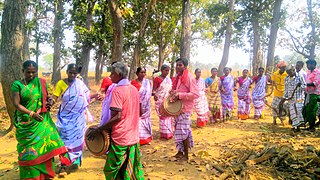
The Santal people are an Austroasiatic-speaking Munda ethnic group of the Indian subcontinent. Santals are the largest tribe in the Jharkhand and West Bengal in terms of population and are also found in the states of Odisha, Bihar and Assam. They are the largest ethnic minority in northern Bangladesh's Rajshahi Division and Rangpur Division. They have a sizeable population in Nepal. The Santals speak Santali, the most widely spoken Munda languages of Austro-asiatic language family.

The Adivasi refers to heterogeneous tribal groups across the Indian subcontinent. The term is a Sanskrit word coined in the 1930s by political activists to give the tribal people an indigenous identity by claiming an indigenous origin. The term is also used for ethnic minorities, such as Chakmas of Bangladesh, Bhumiputara Khasas of Nepal, and Vedda of Sri Lanka. The Constitution of India does not use the word Adivasi, instead referring to Scheduled Tribes and Janjati. The government of India does not officially recognise tribes as indigenous people. The country ratified the International Labour Organization (ILO) Convention 107 on Indigenous and Tribal Peoples of the United Nations (1957) and refused to sign the ILO Convention 169. Most of these groups are included in the Scheduled Tribe category under constitutional provisions in India.

The Kurukh or Oraon, also spelt Uraon, or Dhangar are a Dravidian speaking ethnolinguistic group inhabiting Chhotanagpur Plateau and adjoining areas - mainly the Indian states of Jharkhand, Odisha, Chhattisgarh, and West Bengal. They predominantly speak Kurukh as their native language, which belongs to the Dravidian language family. In Maharashtra, Oraon people are also known as Dhangad or Dhangar.

The Munda people are an Austroasiatic-speaking ethnic group of the Indian subcontinent. They predominantly speak the Mundari language as their native language, which belongs to the Munda subgroup of Austroasiatic languages. The Munda are found mainly concentrated in the south and East Chhotanagpur Plateau region of Jharkhand, Odisha and West Bengal. The Munda also reside in adjacent areas of Madhya Pradesh as well as in portions of Bangladesh, Nepal, and the state of Tripura. They are one of India's largest scheduled tribes. Munda people in Tripura are also known as Mura.

The Kharia are an Austroasiatic tribal ethnic group from east-central India. They originally speak the Kharia language, which belong to Austroasiatic languages. They are sub-divided into three groups known as the Hill Kharia, Delki Kharia and the Dudh Kharia. Amongst them, the Dudh Kharia is the most educated community.

The Baiga are an ethnic group found in central India primarily in the state of Madhya Pradesh, and in smaller numbers in the surrounding states of Uttar Pradesh, Chhattisgarh and Jharkhand. The largest number of Baiga is found in Baiga-chuk in Mandla district and Balaghat district of Madhya Pradesh. They have sub-castes: Bijhwar, Narotia, Bharotiya, Nahar, Rai maina and Kath maina. The name Baiga means "sorcerer-medicine man".
The Kol people referred to tribals of Chotanagpur in Eastern Parts of India. The Mundas, Oraons, Hos and Bhumijs were called Kols by British.
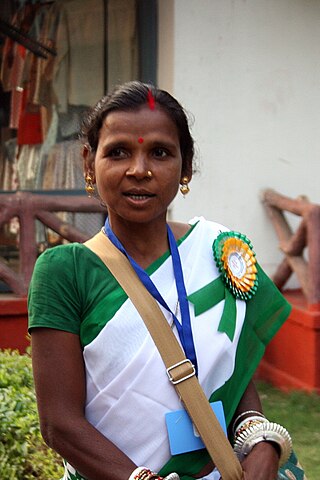
The Ho people are an Austroasiatic Munda ethnic group of India. They call themselves the Ho, Hodoko and Horo, which mean 'human' in their own language. Officially, however, they are mentioned in different subgroups like Kolha, Mundari, Munda, Kol and Kolah in Odisha. They are mostly concentrated in the Kolhan region of Jharkhand and Odisha where they constitute around 10.7% and 7.3% of the total Scheduled Tribe population respectively, as of 2011. With a population of approximately 700,000 in the state in 2001, the Ho are the fourth most numerous Scheduled tribe in Jharkhand after the Santals, Kurukhs, and Mundas. Ho also inhabit adjacent areas in the neighboring states of Odisha, West Bengal and Bihar bringing the total to 806,921 as of 2001. They also live in Bangladesh and Nepal.
Asuri is an Austroasiatic language spoken by the Asur people, part of the Munda branch. Asuri has many Dravidian loanwords due to contact with Kurukh.
Chik Baraik is a community found in Indian State of Jharkhand, Chhattisgarh, Odisha. They were traditionally Weaver.

Bhumij is a Munda ethnic group of India. They primarily live in the Indian states of West Bengal, Odisha, and Jharkhand, mostly in the old Singhbhum district. Also in states like Bihar and Assam. There is also a sizeable population found in Bangladesh. Bhumijas speak the Bhumij language, an Austroasiatic language, and use Ol Onal script for writing.
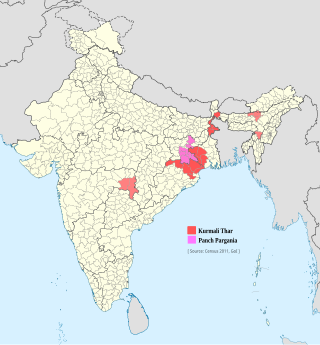
Kurmali or Kudmali is an Indo-Aryan language classified as belonging to the Bihari group of languages spoken in eastern India. As a trade dialect, it is also known as Panchpargania, for the "five parganas" of the region it covers in Jharkhand. Kurmali language is spoken by around 5.5 lakh people mainly in fringe regions of Jharkhand, Odisha and West Bengal, also a sizable population speak Kurmali in Assam tea valleys. Intellectuals claim that Kurmali may be the nearest form of language used in Charyapada. Kurmali is one of the demanded languages for enlisting in Eighth Schedule to the Constitution of India.
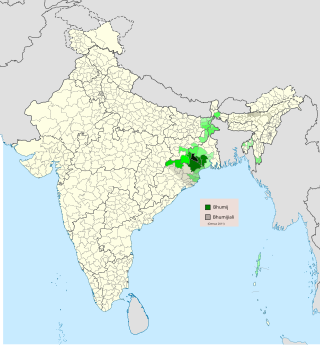
Bhumij is an Austroasiatic language belonging to the Munda subfamily, related to Ho, Mundari, and Santali, primarily spoken by Bhumij peoples in the Indian states Jharkhand, Odisha and West Bengal. As per the 2011 census, only 27,506 people out of 9,11,349 Bhumij people spoke Bhumij as their mother tongue, as most Bhumijas have shifted to one of the regional dominant languages. Thus the language is considered an extremely endangered language.
The Nagpuria people, also Nagpuri or Sadan, are an Indo-Aryan speaking ethnolinguistic group who are the native speakers of the Nagpuri language and natives of the western Chota Nagpur Plateau region of Indian states of Jharkhand, Bihar, Chhattisgarh and Odisha.
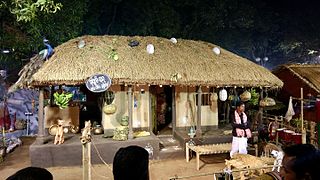
The Bathudi or Bathuri is a community found mainly in the north western part of Odisha. Some Bathudis, however migrated to neighbouring states of Jharkhand and West Bengal. The 2011 census showed their population to be around 220,859. They are classified as a Scheduled Tribe by the Indian government.
The Binjhal is an ethnic group and an offshoot of the Austroasiatic Baiga tribe, are found mainly in many districts of Odisha, Chhatishgarh, Madhya Pradesh and Maharashtra. The 2011 census showed their population to be around 137,040. They are classified as a Scheduled Tribe by the Indian government.
The Binjhia is an ethnic group found in Odisha and Jharkhand. The 2011 census showed their population to be around 25,835. They are classified as a Scheduled Tribe by the Indian government.
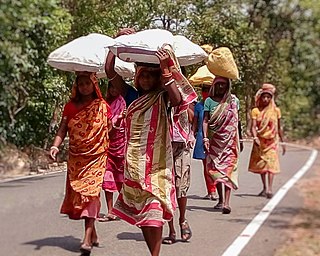
Bagal is a cattle herding caste of East India. Bagal people are living in the state of West Bengal, Jharkhand and Odisha. They use Kudmali / Manbhumi dialect of Bengali as mother tongue and use Bengali, Hindi and Odia language to communicate with the society.
The Karmali is an artisan tribe of Jharkhand. It is composed of blacksmiths. They are mainly concentrated in Ramgarh, Bokaro, Hazaribagh, Giridih and Ranchi district of Jharkhand and sizable population also found in Bihar :- Aurangabad & Rohtas, West Bengal and Assam. They speak Khotta language in their home and Hindi language with society. As per 1981 census their population in the state was 38,651. They are considered as Scheduled Tribe in West Bengal and Jharkhand.
The Turi is a caste found in the state of Jharkhand, Odisha and West Bengal in India. The traditionally involved in the manufacture of household items of bamboo.
References
- 1 2 3 4 5 "Census of India Website : Office of the Registrar General & Census Commissioner, India". www.censusindia.gov.in. Government of India. Retrieved 23 October 2017.
- 1 2 3 Mehta, P.C. (2004). Ethnographic Atlas of Indian Tribes. Discovery Publishing House. p. 340. ISBN 978-81-7141-852-7 . Retrieved 2019-07-24.
- 1 2 Minz, D.; Hansda, D.M. (2010). Encyclopaedia of Scheduled Tribes in Jharkhand. Kalpaz Publications. p. 141. ISBN 978-81-7835-121-6 . Retrieved 2019-07-24.
- 1 2 3 4 5 6 7 scstrti, scstrti. "Kora". Home. Retrieved 2019-07-24.
- ↑ "Archived copy" (PDF). Archived from the original (PDF) on 2017-08-09. Retrieved 2014-07-30.
{{cite web}}: CS1 maint: archived copy as title (link) - ↑ Minz, D.; Hansda, D.M. (2010). Encyclopaedia of Scheduled Tribes in Jharkhand. Kalpaz Publications. p. 144. ISBN 978-81-7835-121-6 . Retrieved 2019-07-24.
- ↑ Minz, D.; Hansda, D.M. (2010). Encyclopaedia of Scheduled Tribes in Jharkhand. Kalpaz Publications. p. 145. ISBN 978-81-7835-121-6 . Retrieved 2019-07-24.
